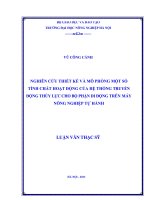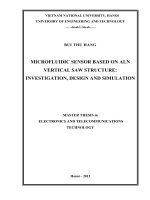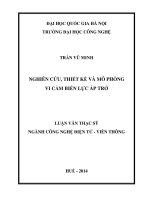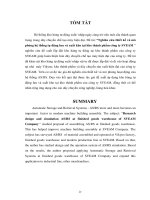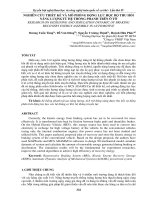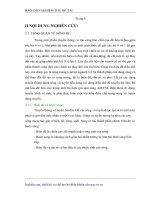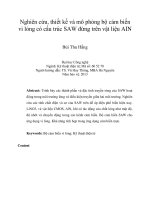Nghiên cứu, thiết kế và mô phỏng bộ cảm biến vi lỏng có cấu trúc SAW đứng trên vật liệu AIN
Bạn đang xem bản rút gọn của tài liệu. Xem và tải ngay bản đầy đủ của tài liệu tại đây (4.01 MB, 62 trang )
VIETNAM NATIONAL UNIVERSITY, HANOI
UNIVERSIRY OF ENGINEERING AND TECHNOLOGY
BUI THU HANG
MICROFLUIDIC SENSOR BASED ON ALN
VERTICAL SAW STRUCTURE:
INVESTIGATION, DESIGN AND SIMULATION
MASTER THESIS in
ELECTRONICS AND TELECOMMUNICATIONS
TECHNOLOGY
Hanoi 2013
-
2013
Microfluidic Sensor based on AlN Vertical SAW structure: Investigation, Design and Simulation
Bui Thu Hang Page 1
TABLE OF CONTENT
GLOSSARY 3
ACKOWNLEDGEMENTS 4
LISTS OF TABLES 5
LISTS OF FIGURES 6
Chapter 1 Introduction 8
1.1 Motivation and Objectives 8
1.2 Organization of Thesis 9
Chapter 2 Theoretical Analysis of the AlN-based Microfluidic Sensor 12
2.1 Introduction 12
2.2 Surface Acoustic Waves 13
2.2.1 Shear Horizontal Surface Acoustic Waves (SH-SAWs) 13
2.2.2 Rayleigh Surface Acoustic Waves (R-SAWs) 14
2.3 Propagation of Acoustic Waves in contact with a Liquid Medium 16
2.3.1 Boundary Conditions 19
2.3.2 Standing and Linear Motion Medium 19
2.3.3 Moving Liquid Medium 20
2.4 Equivalent Circuit Model of SAW Devices 21
2.4.1 Model Implementation 21
2.4.2 Frequency Response 22
2.4.3 Attenuation 22
2.5 Conclusion 23
Chapter 3 3-D Design of AlN-based Microfluidic Sensor 24
3.1 General Description 24
3.2 Design Principles 25
3.3 FEM Simulation for AlN-based Microfluidic Sensor 29
3.3.1 General Configuration 29
3.3.2 Lithium Niobate 30
3.3.3 Aluminium Nitride 33
Microfluidic Sensor based on AlN Vertical SAW structure: Investigation, Design and Simulation
Bui Thu Hang Page 2
3.4 Masks designed 35
Chapter 4 Results and Discussion 38
4.1 General Description 38
4.2 Density and viscosity 38
4.2.1 Lithium Niobate Crystal 38
4.2.2 Aluminium Nitride Crystal 43
4.3 Sensing Liquid Status 45
4.3.1 Constant Velocity 45
4.3.2 Non-constant Velocity 49
4.4 Conclusion 53
Chapter 5 Conclusions and Future Work 54
5.1 Conclusions 54
5.2 Future work 54
Reference 56
Appendix: Material Parameters for Piezoelectric Substrate 59
A. Lithium Niobate 59
B. Aluminium Nitride 59
Microfluidic Sensor based on AlN Vertical SAW structure: Investigation, Design and Simulation
Bui Thu Hang Page 3
IDT InterDigital Transducer
SAW Surface Acoustic Wave
R-SAW Rayleigh Surface Acoustic Wave
SH-SAW Shear-Horizontal Surface Acoustic Wave
LiNbO
3
Lithium Niobate
Mo Molybdenum
Al Aluminium
AlN Aluminium Nitride
Si Silicon
SOI Silicon On Insulator
Microfluidic Sensor based on AlN Vertical SAW structure: Investigation, Design and Simulation
Bui Thu Hang Page 4
I would like to sincerely thank my advisor, Assoc. Prof. Chu Duc Trinh for their
encouragement, guidance, and invaluable supports throughout the course of this
study. He guided me in studying microfluidics and always gave me meaningful and
profound explanations. I would like to gratefully acknowledge Dr. Tran Duc Tan
and Assoc. Prof. Rusu Vasile Catelin for useful suggestions in my dissertation.
Their guidance enabled me to complete my thesis work.
I am also highly thankful to all teachers at Dept. of Electronics and
Telecommunications for supports and encouragement. Many thanks to staff in
department for their helps of thesis defence procedures.
Finally, it is my profound gratitude to my family, especially my mom, my cousin
Phan Quoc Vi for their moral supports and encouragement in my life.
Microfluidic Sensor based on AlN Vertical SAW structure: Investigation, Design and Simulation
Bui Thu Hang Page 5
Table 3.1: Physical properties of the chosen liquids. 33
Table 3.2: Parameters of SAW device based on Aluminium Nitride Crystal. 34
Table 3.3: Design parameters of AlN-based SAW device 34
Table 3.4: The design parameters for AlN-based microfluidic sensor with single
channel. 36
Table 3.5: The design parameters for AlN-based microfluidic sensor with multi-
channel 36
Microfluidic Sensor based on AlN Vertical SAW structure: Investigation, Design and Simulation
Bui Thu Hang Page 6
Figure 1.1: The flow chart for the development process of an AlN-based
Microfluidic Sensor prototype. 10
Figure 2.1: Acoustic wave propagation direction in a Cartesian coordinate system.
13
Figure 2.2: (a) The typical SH-SAW structure. (b) Illustration of shear horizontal
(SH) polarized displacement. 14
Figure 2.3: (a) Schematic of the particle motion for a Rayleigh wave. (b) Ultrasonic
radiation into water by SAW when sensing channel placed on substrate 15
Figure 2.4: (a) The simple SAW structure for sensing liquid. (b) Ultrasonic
radiation into water when sensing channel is placed along the vertical axis of
device. 16
Figure 2.5: Principle construction of multilayer SAW sensor. 17
Figure 2.6: Geometry of the problem for analysing propagation of Rayleigh waves.
18
Figure 2.7: Mason equivalent circuit model. 21
Figure 3.1: Schematic drawing of the integrated inkjet system. 26
Figure 3.2: Top and cross-view of one-channel microfluidic sensor. 27
Figure 3.3: Top and cross-view of two-channel microfluidic sensor. 28
Figure 3.4: Top and cross-view of one-input two-channel microfluidic sensor. 28
Figure 3.5: Top and cross-view of multi-output microfluidic sensor. 29
Figure 3.6: Schematic illustration of two-channel R-SAW sensor and liquid well
position. 30
Figure 3.7: Design parameters of Channel 1 and well size 31
Figure 3.8: Meshed image of 3D SAW model with the well in the middle of the
wave propagation path 32
Figure 3.9: General view for all devices in one die. 35
Figure 4.1: Total displacement of corresponding points in Channel 1 and Channel 2
with different well diameters 39
Microfluidic Sensor based on AlN Vertical SAW structure: Investigation, Design and Simulation
Bui Thu Hang Page 7
Figure 4.2: Total displacement of the well behind points with three liquid types. 40
Figure 4.3: Output voltage of Group 1 from the 3-D SAW model with and without
deposited well from 0 to 130 nsec 41
Figure 4.4: Output voltage of Group 2 from the 3-D SAW model with and without
deposited well from 0 to 130 nsec 43
Figure 4.5: (a) Total displacement envelops of points placed behind the well 43
Figure 4.6: Electrical attenuation response (shown as insertion loss) for the SAW
device. 44
Figure 4.7: The time delay of system with the well having liquid density =1, 3, 6,
and 12 g/cm
3
. 44
Figure 4.8: Potential amplitude at center frequency on the IDT receiver for linear
group 45
Figure 4.9: Ratio coefficient of displacement amplitudes before and after the well
for linear group. 46
Figure 4.10: (a) Delay time and (b) Velocity decay coefficient when liquid moves
linearly. 47
Figure 4.11: Attenuation corresponding to linear motion function. 48
Figure 4.12: Effect of SAWs on linear fluid flow. 49
Figure 4.13: Potential amplitude at center frequency on the IDT receiver for
exponential motion group. 50
Figure 4.14: Ratio coefficient of displacement amplitudes before and after the well
for exponential motion group. 50
Figure 4.15: Velocity decay for exponential motion group. 51
Figure 4.16: Delay time when liquid moves nonlinearly. 51
Figure 4.17: Attenuation corresponding to exponential motion function. 52
Figure 4.18: Effect of SAWs on exponential fluid flow. 52
Microfluidic Sensor based on AlN Vertical SAW structure: Investigation, Design and Simulation
Bui Thu Hang Page 8
Chapter 1
1.1 Motivation and Objectives
In recent years, microfluidic technology received a lot of attention because its
widespread applications in printing, biomedicine. Device integration and
miniaturization based on microfluidic technology has been growing up quickly. In
addition, expected devices may have advantages such as: small size, facile usage
and low cost, fast detection speed, high accuracy, less consumption power and high
integration capability. One of the present microfluidic technologies utilizes surface
acoustic wave (SAW) [1][2].
It is well-known owing to applications such as actuators, antennas and driven
droplet manipulation using SAW atomization and jetting technique [3][4][5]. SAW
devices are also widely utilized in sensors [6]. Such devices convert electrical
energy into mechanical energy and vice versa. Specifically, when the
transformation from electrical to mechanical energy occurs at the InterDigital
Transducder (IDT) transmitter, acoustic waves travel through the surface. SAW
waves include Rayleigh waves, and sliding shear waves. The amplitude of the
Rayleigh-SAWs of around 10Å is very small and exponentially declines. Because
wave penetration into the substrate is inversely proportional to frequency, in order
to limit reflections and refractions at the bottom, the material size is large enough.
This mechanical vibration on the surface continues until opposite transform process
at the IDT receiver. Waves that do not retransform electrical energy at the receiver
are absorbed by wax, polyimide placed before and after the input and output IDT.
Sensing mechanism is electrical perturbation on the IDT receiver due to obstacles
on the propagation path or even if R-SAWs travel through the different media [7].
Prominent advantages of SAW devices are micro derivation size for fluid, high
sensitivity and fabrication ability on compatible material. The structure trend is
vertical sensing channel. This suggests the requirement of the vertical SAW sensor.
Microfluidic Sensor based on AlN Vertical SAW structure: Investigation, Design and Simulation
Bui Thu Hang Page 9
Moreover, the acoustic wave propagation strongly depends on the properties of
nanostructure sensing layers which in turn can be altered by the wave vibration
itself. Here, it is able to be piezoelectric thin film on the substrate or piezoelectric
crystal such as quartz, Lithium Tantalate (LiTaO
3
), Lithium Niobate (LiNbO
3
),
especially Aluminium Nitride (AlN) because of high frequency and being
compatible with the CMOS technology. Thus, it is necessary to understand both the
wave propagation and the nanomaterial properties in order to uncover the sensing
mechanism and improve the performance of acoustic sensors. This dissertation
focuses:
1. Understanding the components and the propagation characteristics of liquid
SAW devices.
2. Investigating the electrical and mechanical properties of SAW devices on
common piezoelectric, LiNO
3
, and CMOS material, AlN, when there are
impacts of fluid such as density, viscosity and motion in the sensing channel.
3. Developing novel SAW sensors for microfluidics.
4. Integration ability in ink sensing applications.
1.2 Organization of Thesis
We adopt the development process in Figure 1.1. It is assumed that the SAW sensor
works in an ideal environment. The theoretical derivation and analysis are
performed to qualitatively verify the proposed design. In order to achieve the
quantitative analysis, the finite element method (FEM) will be studied and
implemented with the software Comsol Multiphysics. According to these
verification results, it demonstrates the fabrication capacity of the AlN-based
microfluidic sensor in the future.
Microfluidic Sensor based on AlN Vertical SAW structure: Investigation, Design and Simulation
Bui Thu Hang Page 10
Figure 1.1: The flow chart for the development process of an AlN-based Microfluidic
Sensor prototype.
The dissertation is organized as following:
Chapter two describes the acoustic waves in the piezoelectric and liquid medium. It
gives electrical properties of SAW devices through the equivalent Mason circuit.
Also, the analysis of leaky phenomenon induced by Rayleigh wave interaction with
the liquid medium is presented.
Chapter three discusses the design and realization of SAW microfluidic sensor
using LiNbO
3
, AlN. Modelling procedure is conducted by Finite Element Method
(FEM). Optimization of sensor parameters in the simulation driving to enhanced
amplitude fields and lower propagation loses; thereby increasing device sensitivity
is discussed. Besides, several masks in the experiment are described.
Microfluidic Sensor based on AlN Vertical SAW structure: Investigation, Design and Simulation
Bui Thu Hang Page 11
Chapter four is the major simulation results for sensing density and status of liquid
in the well, the explanations and analyses of obtained results.
Chapter five summarizes the main contributions and provides suggestions for
possible future studies.
Microfluidic Sensor based on AlN Vertical SAW structure: Investigation, Design and Simulation
Bui Thu Hang Page 12
Chapter 2 -
2.1 Introduction
SAW devices have been studied in chemistry, biomedicine and telecommunication
for many decades, especially sensors including automotive (torque and tire pressure
sensors), medical applications (biosensors) and industrial, commercial applications
(vapour, humidity, temperature and mass sensors) [8]. Measurands on acoustic
wave sensor are wave velocity perturbation, changes of confinement dimensions,
degree of the traveling wave damping and input-output variation [9]. An important
distinction between types can be defined according to the natures of the acoustic
wave and vibration modes. Traveling waves can be bulk acoustic waves (BAWs)
propagating on the interior of the substrate and SAWs on the surface.
To the SAW sensor, a mechanical wave, generated by piezoelectric crystal using
metal electrodes or called interdigital transducers (IDTs), travels along the surface
[6][10]. It includes a Rayleigh and a shear mode which propagate through the
surface as shown in Figure 2.1. The Rayleigh mode, called Rayleigh wave, is a
combination of longitudinal and shear vertical particle displacement while the shear
mode, called Shear Horizontal – Surface Acoustic Wave (SH-SAW), is a shear
horizontal wave on the surface [11][12].
Other surface waves are Love waves (LWs) where the acoustic waves are guided in
the foreign layer and surface transverse waves (STW) where guiding waves are on a
piezoelectric substrate under a shallow groove or on thin metal strip gratings [13].
Microfluidic Sensor based on AlN Vertical SAW structure: Investigation, Design and Simulation
Bui Thu Hang Page 13
Figure 2.1: Acoustic wave propagation direction in a Cartesian coordinate system.
(a) Compressional or longitudinal; (b) Shear vertical; (c) Shear horizontal.
2.2 Surface Acoustic Waves
2.2.1 Shear Horizontal Surface Acoustic Waves (SH-SAWs)
A typical structure of SH-SAW device for liquid has a horizontal channel on the
substrate (see Figure 2.2a). When the liquid is loaded on the propagating surface,
the SH-SAWs can travel along the interface between the liquid and the substrate
and are influenced by its properties as shown in Figure 2.2b. As the penetration
depth of the shear horizontal (SH) particle into liquid is very low, SH-mode SAW
sensors were utilized for sensing liquid without significant radiation losses [14]. For
example, in 1977, Nakamura et al. proposed a pseudo SH-SAW on the 36-degree
rorated Y-cut X-propagating LiTaO
3
(36YXLT). In 1999, Shiokawa et al. presented
a liquid-phase sensor using a SH-SAW on the 36YXLT [15].
Microfluidic Sensor based on AlN Vertical SAW structure: Investigation, Design and Simulation
Bui Thu Hang Page 14
Figure 2.2: (a) The typical SH-SAW structure. (b) Illustration of shear horizontal
(SH) polarized displacement.
2.2.2 Rayleigh Surface Acoustic Waves (R-SAWs)
As mentioned above, Rayleigh wave is composed of compressional or longitudinal
displacement and shear vertical displacements while the compressional component
is confined at the surface down to a penetration depth of the order of the
wavelength. The particle motion in the piezoelectric where Rayleigh waves pass is
sought in the form of an ellipse as shown in Figure 2.3a [16]. Hence, Rayleigh with
a particle displacement perpendicular to the device surface can be radiated into the
liquid medium and cause an excessive attenuation if the contact between liquid and
piezoelectric is too large. On the other hand, leaky SAWs that are converted from
Microfluidic Sensor based on AlN Vertical SAW structure: Investigation, Design and Simulation
Bui Thu Hang Page 15
SAWs are excited at a Rayleigh angle
R
in the boundary and consequently their
energy radiates into the liquid in Figure 2.3b. It is difficult to realize a liquid-phase
by the Rayleigh wave devices when the liquid is placed on the piezoelectric.
Figure 2.3: (a) Schematic of the particle motion for a Rayleigh wave. (b) Ultrasonic
radiation into water by SAW when sensing channel placed on substrate
We proposed a novel vertical structure for the liquid sensing applications based on
Rayleigh waves in Figure 2.4a [14]. The key is that the solid-liquid contact area,
closing to surface, is smaller (as shown in Figure 2.4b). It is presented that there
exists a liquid medium in the propagation path with the coordinate system, thereby
the longitudinal component should have an inappreciable attenuation.
Microfluidic Sensor based on AlN Vertical SAW structure: Investigation, Design and Simulation
Bui Thu Hang Page 16
Figure 2.4: (a) The simple SAW structure for sensing liquid. (b) Ultrasonic radiation
into water when sensing channel is placed along the vertical axis of device.
2.3 Propagation of Acoustic Waves in contact with a Liquid
Medium
As the SAW motion spreads below the surface to a depth of about one wavelength
[7], the effect of the second layer below the piezoelectric might be ignored if the
thin film is thick. So, it is assumed that the thin film is thick enough to prevent
acoustic waves from reflecting on the bottom, reflection wave interference
phenomenon may be cancelled. The geometry of acoustic waves propagating in a
piezoelectric substrate in contact with a fluid and solid medium is shown in Figure
2.5. To satisfy the stress-free boundary, compression and shear waves propagate
together on the substrate. It is assumed that the generalized surface acoustic wave
Microfluidic Sensor based on AlN Vertical SAW structure: Investigation, Design and Simulation
Bui Thu Hang Page 17
propagates in the (X
1
, X
2
) and has a displacement profile which varies with the
depth X
3
of the single-crystal (see Figure 2.6):
(1),
where k is the wave number, is the velocity of the wave, b is the decay constant of
the wave in the X
3
direction, X
1
, X
2
, X
3
is the unit vectors and (l
1
, l
2
) is the set of
propagation direction along the surface. The component X
3
is perpendicular to the
surface and W
1
, W
2
, W
3
represent the displacement amplitudes of the X
1
, X
2
and X
3
directions, respectively. It is assumed that there exists a liquid medium positioned in
the propagation path with the coordinate system.
The Rayleigh wave is characterized by the absence of a transversal component.
Thus Eq. 1 omits X
2
and l
1
equals to the unit. Hence, the travelling wave form is
independent of the X
2
coordinate. Since the displacement component u
2
is removed,
l
2
is zero.
Figure 2.5: Principle construction of multilayer SAW sensor.
Microfluidic Sensor based on AlN Vertical SAW structure: Investigation, Design and Simulation
Bui Thu Hang Page 18
Figure 2.6: Geometry of the problem for analysing propagation of Rayleigh waves.
In the following, the fluid situation is considered. For a non-conducting, non-
viscous fluid, the elastic constant matrix is presented in the Appendix. As the
direction of fluid flow is across the X
3
coordinate, generated the surface acoustic
wave travels in the direction X
1
and has a displacement profile
that varies with
depth X
3
into the piezoelectric substrate as following:
(2)
(3)
(4),
where k is the wave number, is the acoustic wave velocity in the liquid medium, b
f
is the decay constant of the wave in the X
3
direction and (l
1
, l
2
) is the set of
propagation direction along the liquid medium and W
2
is the weight of the potential
. The component X
3
is perpendicular to the surface and W
1
, W
3
represent the
displacement amplitudes of the X
1
and X
3
directions, respectively. is the fluid
motion function which disturbs not only the acoustic wave velocity but also the
decay constant b
f
. The fluid viscosity is ignored in Eq. 1.
Microfluidic Sensor based on AlN Vertical SAW structure: Investigation, Design and Simulation
Bui Thu Hang Page 19
2.3.1 Boundary Conditions
At the liquid-solid interface, as the normal and propagation components of the
particle displacement
,
and the electric potential
are continuous and the
boundary conditions are
,
and
. The effect of coupling
the displacements and the potential can be illustrated by [7]:
(5),
where
and
are the piezoelectric stress constants and the permittivity tensors
(as shown in Appendix).
Substituting Eq. 1, 2, 3 and 4 into Eq. 5, in the case of LiNbO
3
piezoelectric crystal,
it leads to relationship between the weight of potential and displacement as
following:
(6),
Also, in the case of AlN substrate, it is:
(7),
where m is the rate coefficient of W
1
and W
2
. Eq. (7) indicates the relation between
the electrical and the displacement magnitude in piezoelectric substrate.
2.3.2 Standing and Linear Motion Medium
According to Newton’s Law, the equation of motion in the non-piezoelectric is
found:
(8)
Microfluidic Sensor based on AlN Vertical SAW structure: Investigation, Design and Simulation
Bui Thu Hang Page 20
(9),
where
is the elastic constant of liquid,
is the liquid density.
In the case of the standing liquid medium, is ignored in Eq. (3). Thus, from
Eqs. 7 and 8, it gives:
(10)
(11).
Following Eqs. 10 and 11, these surface waveforms depend on the liquid density.
Hence, with different materials, the amplitude and phase of the particle
displacement of the leaky wave are changed.
When the fluid motion is linear, the second order differential equation of the
normal displacement rejects the flow influence. The solution of this equation is
similar to the case of standing liquid medium.
2.3.3 Moving Liquid Medium
If the liquid velocity is non-linear, the motion equations in this case have an
existence of fluid velocity which is sought in the form:
(12)
(13),
where
is the velocity function of liquid streaming. Following the Eqs.
7, 12 and 13, both the surface wave form and potential are influenced. In this case,
Microfluidic Sensor based on AlN Vertical SAW structure: Investigation, Design and Simulation
Bui Thu Hang Page 21
it is hard to define the order of the fluid motion function as both the numerator and
denominator are function of liquid velocity in the well.
2.4 Equivalent Circuit Model of SAW Devices
2.4.1 Model Implementation
Without the well, the SAW device can be modelled with the Impulse Response
method based on the Mason equivalent circuit (Figure 2.7) [18]. It has been widely
applied on different types of SAW sensors to calculate qualitative results on the
receiver. According to this figure, the source voltage and both the source and load
impedances are not part of this model.
Figure 2.7: Mason equivalent circuit model.
For each IDT, the model includes the radiation conductance G
a
(f), the acoustic
susceptance B
a
(f) and the total capacitance C
T
[19]. The number of finger pairs or
IDTs (N
p
) and the wavelength are calculated in the following:
(14)
(15),
where is the acoustic velocity on the piezoelectric, f
0
is the center frequency and
BW is the bandwidth.
Microfluidic Sensor based on AlN Vertical SAW structure: Investigation, Design and Simulation
Bui Thu Hang Page 22
2.4.2 Frequency Response
Theoretically, a linear time invariant system (LTI) may be characterized by an
impulse response h(t). Deriving from the impulse response h(t) for a SAW device,
we can obtain the frequency response to investigate changes on the receiver.
Without the well, the frequency response H
1
(f) of the SAW device is the ratio V
2
over V
1
and is sought in the form of the cardinal sine function:
(16)
where f is the frequency, k is the piezoelectric coupling coefficient, D is the delay
between IDTs in the wavelengths, C
s
is the capacitance for a finger pair per length.
The variable X is defined by:
(17),
With the well, the frequency response H(f) of the SAW device is represented by:
(18),
where H
2
(f) is the frequency response which is produced by liquid impacts in the
well such as chemical and physical properties.
2.4.3 Attenuation
The electrical attenuation response is regarded as the insertion loss of electrical
systems. For SAW devices, insertion loss is a function of frequency:
(19),
The minimum insertion loss occurs when f = f
0
, the center frequency. When the
well is located in the middle of the propagation path, attenuation reduces because of
the leaky acoustic waves traveling through piezoelectric-liquid media. As above
Microfluidic Sensor based on AlN Vertical SAW structure: Investigation, Design and Simulation
Bui Thu Hang Page 23
output potential calculation for different densities and liquid state, attenuation is
also influenced.
2.5 Conclusion
According to the mechanical and electrical theory analysis, the AlN-based SAW
structure is able to detect different liquids in the well by density value whereas the
viscosity influence does not low. Also, liquid velocity is an impact of changes on
the output IDTs. Mechanical characteristic analysis may help determine the relation
between flow motion and output signal.
